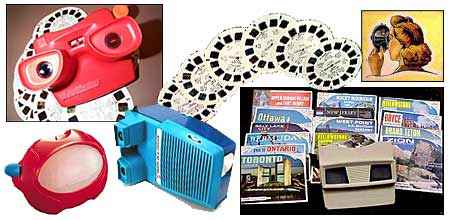View-Master

Synopsis of Toy
If you took any pride at all in your toy chest—and we hope you did—it surely contained a View-Master. When the action figure war-simulation wound down and you needed a short intermission before you began construction on a fort made out of couch cushions and every single pillow your house had to offer, the View-Master was where you went for some quiet, rejuvenating "me-time."
Now how would you feel about an endless string of technical phrases? You'd be okay with that? Splendid. In 1938, William Gruber conceived of an apparatus that would take color photos, the transparencies of which he could lay over one another to create a 3-D image, which could then be peered at through a hand-held device with two eyepieces.
Of course, anything that demands a sentence like that is going to cost a pretty penny to get off the ground, and this is where Mother Nature lent a hand. When Gruber was visiting the Oregon Caves National Monument with his wife, he met a fellow tourist named Harold Graves, who was the president of a company called Sawyer’s Photographic Services. The two camera buffs had a lot in common and talked long into the night, and the next year, they joined forces to manufacture the first View-Master. It hit the shelves in Portland, Oregon, and was marketed towards nature buffs—the first reels were sights like Colorado’s Pikes Peak and Virginia’s Luray Caverns. The nature buffs had apparently been socking pennies away in their backpacks, because sales were brisk.
By the early 1940’s, the World War II years, it wasn’t just the tree-huggers were went in for the View-Masters—it was the tank-huggers too. The U.S. Military purchased 100,000 viewers and over six million reels for training purposes. In 1951, Sawyer purchased the Tru-Vu Stereo Film Company, and with it, the rights to their Stereochrome viewers and their license to use Disney characters. Not that points of geographic interest aren’t perfectly nice to look at, but now View-Masters offered glimpses at subjects that were substantially more fun.
The General Aniline and Film Corporation (GAF for short) bought Sawyer in 1966. GAF had manufactured slide and Super 8 movie projectors, and with them at the helm, reel sets from popular 60’s and 70’s TV shows and movies were made available. If you wanted a heavier dose of your favorite screen personalities, plop that Brady Bunch or Planet of the Apes reel in, line the arrow up, hit the spring-loaded lever, listen for that great plasticky click, and give ‘em a whirl. For the science buffs, there were still reels that harkened back to the early, more literal-minded View-Master days and chronicled things like the moon landing.
It’s a low-tech toy: no batteries required or electricity needed, and the only loose parts are the disc reels. Some of these came with a story booklet which a viewer could flip through while he viewed, but a few reels had little self-contained narratives of their own—text would appear in the middle of the viewer. GAF also introduced a short-lived "talking" version, in which an audio track played as the viewer clicked through the photos, as well as models that could project their pictures up onto a wall.
Sales ebbed in the 70’s with the advent of things circuitry-related, but the View-Master hasn’t called it quits yet. It’s owned by Fisher-Price these days, and is geared toward young children. Britney Spears has replaced the likes of Spider-Man, but hey, a for-your-eyes-only 3-D slide show is always great—whether its star is animated or not.
Release History of Toy
1939 - View-Master1940's - Sawyer reels
1951 - Tru-Vu reels
1966 - GAF reels
Sub Categories of Toys
tv tie-inother
